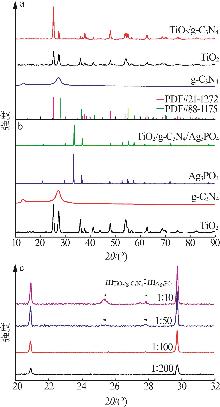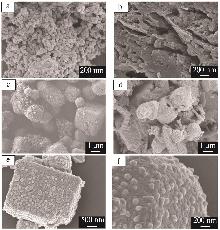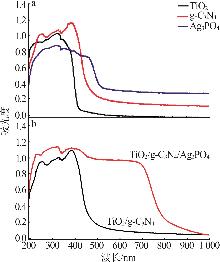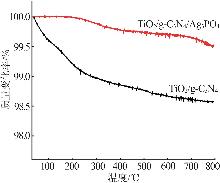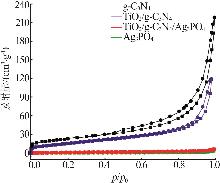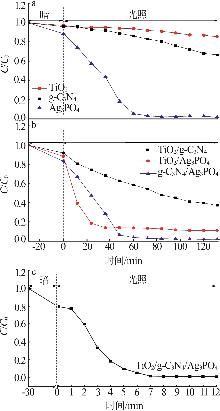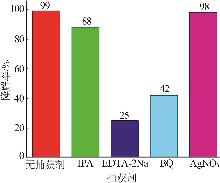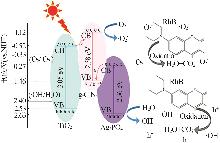Inorganic Chemicals Industry ›› 2025, Vol. 57 ›› Issue (5): 116-124.doi: 10.19964/j.issn.1006-4990.2024-0501
• Catalytic Materials • Previous Articles Next Articles
Study on preparation and visible⁃light photocatalytic properties of TiO2/g-C3N4/Ag3PO4 heterojunction
ZHU Jianjun( ), LIU Peiting, HAN Wenbo, WANG Jing
), LIU Peiting, HAN Wenbo, WANG Jing
- College of Chemistry and Chemical Engineering,Xinyang Normal Univeristry,Xinyang 464000,China
-
Received:2024-09-18Online:2025-05-10Published:2024-12-10
CLC Number:
Cite this article
ZHU Jianjun, LIU Peiting, HAN Wenbo, WANG Jing. Study on preparation and visible⁃light photocatalytic properties of TiO2/g-C3N4/Ag3PO4 heterojunction[J]. Inorganic Chemicals Industry, 2025, 57(5): 116-124.
share this article
| 1 | FUJISHIMA A, HONDA K.Electrochemical photolysis of water at a semiconductor electrode[J].Nature,1972,238(5358):37-38. |
| 2 | PARK J Y.How titanium dioxide cleans itself[J].Science,2018,361(6404):753. |
| 3 | LUGO-RUIZ A A, BAILÓN-RUIZ S J.Titanium nanostructures:Advancing photocatalysis in complex systems[J].Photochem,2024,4(2):222-232. |
| 4 | WU Huasheng, LI Lingxiangyu, WANG Sen,et al.Recent advances of semiconductor photocatalysis for water pollutant treatment:Mechanisms,materials and applications[J].Physical Chemistry Chemical Physics,2023,25(38):25899-25924. |
| 5 | ZHU Jianjun, LI Peizhou, GUO Wenhan,et al.Titanium⁃based metal⁃organic frameworks for photocatalytic applications[J].Coordination Chemistry Reviews,2018,359:80-101. |
| 6 | FUJISHIMA A, RAO T N, TRYK D A.Titanium dioxide photocatalysis[J].Journal of Photochemistry and Photobiology C:Photochemistry Reviews,2000,1(1):1-21. |
| 7 | YADAV S, JILANI A, SACHAN S,et al.Highly efficient visible⁃light⁃driven photocatalysis of rose bengal dye and hydrogen production using Ag@Cu/TiO2 ternary nanocomposites[J].Chemistry,2024,6(3):489-505. |
| 8 | DU Shiwen, LIAN Juhong, ZHANG Fuxiang.Visible light⁃responsive N-doped TiO2 photocatalysis:Synthesis,characterizations,and applications[J].Transactions of Tianjin University,2022,28(1):33-52. |
| 9 | 朱建君,陈宇洋,朱威研,等.石墨烯纳米复合物的制备及其可见光催化性能[J].信阳师范学院学报(自然科学版),2018,31(1):78-82. |
| ZHU Jianjun, CHEN Yuyang, ZHU Weiyan,et al.Preparation and visible light photocatalytic property of TiO2/graphene nanocomposites[J].Journal of Xinyang Normal University(Natural Science Edition),2018,31(1):78-82. | |
| 10 | YI Zhiguo, YE Jinhua, KIKUGAWA N,et al.An orthophosphate semiconductor with photooxidation properties under visible⁃light irradiation[J].Nature Materials,2010,9(7):559-564. |
| 11 | 于红超,张梦萌,金天翔.磷酸银光催化材料的微观形貌及晶面效应研究进展[J].无机盐工业,2023,55(8):13-20. |
| YU Hongchao, ZHANG Mengmeng, JIN Tianxiang.Research progress of microstructure and crystal surface effect of Ag3PO4 photocatalysts[J].Inorganic Chemicals Industry,2023,55(8):13-20. | |
| 12 | YAO Yu, SHEN Qianhong, CHEN Qifeng,et al.Ag/AgX(X=Cl,Br,or I) nanocomposite loaded on Ag3PO4 tetrapods as a photocatalyst for the degradation of contaminants[J].ACS Applied Nano Materials,2024,7(4):3711-3723. |
| 13 | 蓝秀权,华涛,林家亮,等.Ag3PO4-NSG光催化剂的制备及其光催化抗菌性能[J].环境科学学报,2023,43(9):28-37. |
| LAN Xiuquan, HUA Tao, LIN Jialiang,et al.Preparation of Ag3PO4-NSG photocatalyst and their photocatalytic antibacterial properties[J].Acta Scientiae Circumstantiae,2023,43(9):28- 37. | |
| 14 | 尹艳菲,霍敬豪,李海帅,等.Ag/Ag3PO4/CNTs复合材料的光催化杀菌性能及机理[J].功能材料,2024,55(10):10121-10126. |
| YIN Yanfei, HUO Jinghao, LI Haishuai,et al.Photocatalytic sterilization performance and mechanism of Ag/Ag3PO4/CNTs composites[J].Journal of Functional Materials,2024,55(10):10121-10126. | |
| 15 | 陈彰旭,朱丹琛,傅明连.g-C3N4/TiO2复合材料制备及其处理罗丹明B研究[J].无机盐工业,2023,55(7):130-136. |
| CHEN Zhangxu, ZHU Danchen, FU Minglian.Study on preparation of g-C3N4/TiO2 composites and application for rhodamine B removal[J].Inorganic Chemicals Industry,2023,55(7):130- 136. | |
| 16 | 周健,汤洪波.钨酸锌/磷酸银复合光催化剂的制备及光催化性能[J].无机盐工业,2020,52(6):101-104. |
| ZHOU Jian, TANG Hongbo.Preparation and photocatalytic properties of ZnWO4/Ag3PO4 composite photocatalyst[J].Inorganic Chemicals Industry,2020,52(6):101-104. | |
| 17 | LEE J, KIM J.Cooperative design of the Ag3PO4/NH2-MIL-88B (Fe/Co) heterojunction integrated with conductive polypyrrole for advanced photocatalytic water purification[J].ACS Omega,2024,9(5):5942-5953. |
| 18 | WANG Peng, LI Yaru, LIU Zhongmin,et al. In-situ deposition of Ag3PO4 on TiO2 nanosheets dominated by(001) facets for enhanced photocatalytic activities and recyclability[J].Ceramics International,2017,43(15):11588-11595. |
| 19 | 苏琼,张博文,张平,等.Ag3PO4/多孔氮化硼复合材料的制备及可见光催化性能[J].化学通报,2023,86(9):1119-1125,1052. |
| SU Qiong, ZHANG Bowen, ZHANG Ping,et al.Preparation and visible-light photocatalytic properties of Ag3PO4/PBN composite materials[J].Chemistry,2023,86(9):1119-1125,1052. | |
| 20 | 汲畅,王国胜.Ag3PO4/g-C3N4异质结催化剂可见光降解黄连素[J].无机盐工业,2022,54(4):175-180. |
| JI Chang, WANG Guosheng.Degradation of berberine by visible light over Ag3PO4/g-C3N4 heterojunction catalyst[J].Inorganic Chemicals Industry,2022,54(4):175-180. | |
| 21 | 陈龙.金属氧化物/磷酸银异质结复合材料的制备及光催化性能的研究[D].杭州:浙江理工大学,2023. |
| CHEN Long.Preparation and photocatalytic properties of metal oxide/Ag3PO4 heterojunction composites[D].Hangzhou:Zhejiang Sci-Tech University,2023. | |
| 22 | 陈海君.磷酸银基纳米材料的制备及其光催化降解四环素的性能研究[D].长春:吉林大学,2023. |
| CHEN Haijun.Preparation of silver phosphate⁃based nanomaterials and study on the photocatalytic degradation of tetracycline hydrochloride[D].Changchun:Jilin University,2023. |
| [1] | ZHANG Dian. Degradation performance analysis of S-scheme activated carbon supported g-C3N4/TiO2 photocatalytic concrete [J]. Inorganic Chemicals Industry, 2025, 57(4): 118-127. |
| [2] | SHI Wangfang, ZHANG Yongsheng. Study on NO x degradation performance of concrete-based non-metallic boron doped nitrogen-rich carbon nitride [J]. Inorganic Chemicals Industry, 2025, 57(3): 116-123. |
| [3] | LI Zihan, ZHANG Jiaqi, LI Shizhuo, LI Xinyu, LIU Shaozhuo, WANG Yihao, HAO Yucui, LIU Jian, LI Yanhua. Study on synthesis and catalytic mechanism of CdS/g-C3N4 composite photocatalyst [J]. Inorganic Chemicals Industry, 2025, 57(3): 124-132. |
| [4] | SUN Qinghao, LI Keyan, GUO Xinwen. Study on photocatalytic benzyl alcohol oxidation coupled with hydrogen production over Pd/ZnIn2S4 nanosheets [J]. Inorganic Chemicals Industry, 2025, 57(1): 113-119. |
| [5] | LIU Guangming. Study on photocatalytic and mechanical properties of C3N5/NH2-MIL-125(Ti) modified concrete mortar [J]. Inorganic Chemicals Industry, 2025, 57(1): 120-128. |
| [6] | ZHANG Feigang, LIU Zhongli. Study on application of CuO/g-C3N4 composites in organic dye degradation and supercapacitors [J]. Inorganic Chemicals Industry, 2025, 57(1): 129-136. |
| [7] | ZHANG Guoqiang, RONG Xilin, XIAO Zhenfang, XUE Ziran, CHENG Hao, FENG Jun, LIU Quan, LU Yao, HUANG Wenyi. Study on preparation and photocatalytic properties of bagasse carbon aerogels loaded with zinc oxide nanoparticles [J]. Inorganic Chemicals Industry, 2024, 56(8): 131-138. |
| [8] | WANG Yawen, WANG Fangfang, GENG Siyu, JU Jia, CHEN Lei, CHEN Changdong. Study on preparation and photocatalytic performance of SrTiO3-SrWO4 [J]. Inorganic Chemicals Industry, 2024, 56(7): 143-149. |
| [9] | LIU Min, HUANG Xiu, ZHANG Liyuan. Research progress of S-type heterojunction photocatalysts [J]. Inorganic Chemicals Industry, 2024, 56(7): 18-27. |
| [10] | LI Jiangpeng, ZHANG Huibin. Synergistic degradation of methylene blue by photo-Fenton and photocatalytic with 3D porous LaFeO3/CeO2/SrTiO3 [J]. Inorganic Chemicals Industry, 2024, 56(5): 141-148. |
| [11] | TANG Bei. Preparation of ZnO/g-C3N4 heterojunction photocatalytic material and its degradation of pyridine [J]. Inorganic Chemicals Industry, 2024, 56(4): 133-142. |
| [12] | HUANG Jianan, LU Xiaoyu, WANG Mitang. Effect of Ba-La co-doping on degradation of methylene blue dye by TaON [J]. Inorganic Chemicals Industry, 2024, 56(2): 146-151. |
| [13] | ZUO Guangling, WANG Minghui, PENG Yunying, DU Jia, YE Hongyong. Study on hnoneycomb-like LaVO4/Bi2O3 heterojunction for photocatalytic degradation of tetracycline hydrochloride [J]. Inorganic Chemicals Industry, 2024, 56(11): 158-164. |
| [14] | CUI Xiangdong, LIU Sile. Study on photoelectric performance analysis of g-C3N5 nanorods and removal of Cr(Ⅵ) and methylene blue [J]. Inorganic Chemicals Industry, 2024, 56(10): 159-168. |
| [15] | YAN Yu, ZHOU Wenyuan, YANG Yunfei, WU Junshu, WANG Jinshu, SUN Lingmin. Study on surface regulation of sodium ferric silicate photocatalyst and its enhanced Cr(Ⅵ) photoreduction properties [J]. Inorganic Chemicals Industry, 2024, 56(10): 141-150. |
| Viewed | ||||||
|
Full text |
|
|||||
|
Abstract |
|
|||||
|
||
